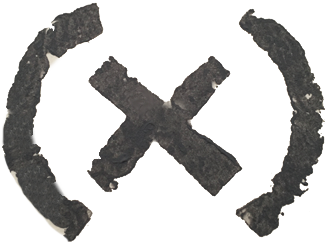Agnes Martin, Little Sister
ARTIST
b. 1912, Macklin, Saskatchewan, Canada; d. 2004, Taos, New Mexico
DATE
MEDIUM
Oil, ink, and brass nails on canvas and wood
(see full image of wood frame here)
DIMENSIONS
9 7/8 x 9 11/16 inches (25.1 x 24.6 cm)
CREDIT LINE
Solomon R. Guggenheim Museum, New York, Gift, Andrew Powie Fuller and Geraldine Spreckels Fuller Collection, 1999
ADDED TO WISHLIST BY
Sam Tripodi
From the Guggenheim website for the AM retrospective
In fall 1958, after her first New York solo exhibition at the Betty Parsons Gallery, Agnes Martin abandoned her earlier biomorphic abstractions and embarked on a series of square-format works featuring the all-over geometric template of the grid. Martin used serial procedures and noncompositional strategies that involved intersecting or adjacent horizontal and vertical marks, and integrated the practices of painting and drawing.
In the 1960 ink drawing Untitled #16, Martin formed an all-over pattern made of horizontal rows of dots and dash-like broken lines, overlaying larger elliptical shapes that both cancel and emphasize the optical vibrations created by her disjointed graphic marks. The stains of smudged ink, the irregularity of the dots, and the unevenness of the lines reflect the fragile contingency of the artist’s touch. A recurring motif in her early 1960s work, dot-dash patterns also appear in the painting White Flower (1960) and in the ink-and-pencil drawing Untitled (Drawing) #31 (1960), where vertical lines and horizontal dot-dash traces together form rectangles surrounded by an empty border. The blank frame, a common device in Martin’s practice, makes the drawn structure appear as a figure on a ground, disrupting the grid’s suggestion of infinite expansion. Enclosures and frames also play an important role in an untitled work from 1960 and Little Sister (1962). The everyday materials such as brass nails in Little Sister recall Martin’s 1950s planar constructions, which she built from found objects and later destroyed. Reminiscent of her dot-dash marks, the nail heads emphasize the materiality of the support and produce a staccato rhythm that thwarts the continuity of the unevenly drawn ink lines.
In contrast to the early 1960s works, Martin’s late ’70s watercolors feature lateral expanses of delicately colored washes rich in atmospheric effects. Two 1977 works on paper (both untitled) consist of wide, horizontal pencil lines and blue, pink, and yellow watercolor stains; the negative space created by a blank area is as important as the colors around it. They belong to a group of works Martin began after her 1973 retrospective at Philadelphia’s Institute of Contemporary Art, which marked the end of her six-year withdrawal from painting, and first showed in spring 1978 at the Pace Gallery in New York. Their luminous color washes emphasize the interdependence of color and form, opacity and transparency, and line and field by appearing to dissolve the geometry of the horizontal areas. Informed by her interest in Taoism, Zen Buddhism, and by her sensory memories and experiences of nature, especially of the Southwestern landscape, Martin’s paintings and drawings consist of sequences of cadenced variations of austere forms and engender a wide range of optical and textural allusions. As the artist put it, the works “are light, lightness, about merging, about formlessness, breaking down forms.”¹
Ágnes Berecz
1. Agnes Martin, quoted in Ann Wilson,“Linear Webs,” Art and Artists 1, no. 7 (Oct. 1966), p. 49.


